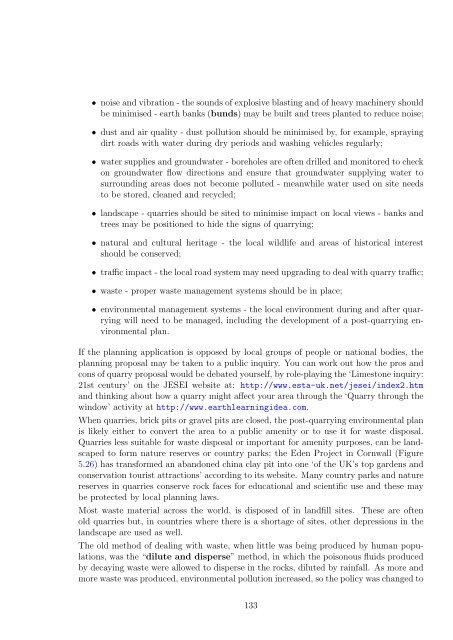The planet we live on: The beginnings of the Earth Sciences
The planet we live on: The beginnings of the Earth Sciences
The planet we live on: The beginnings of the Earth Sciences
- No tags were found...
Create successful ePaper yourself
Turn your PDF publications into a flip-book with our unique Google optimized e-Paper software.
• noise and vibrati<strong>on</strong> - <strong>the</strong> sounds <strong>of</strong> explosive blasting and <strong>of</strong> heavy machinery shouldbe minimised - earth banks (bunds) may be built and trees planted to reduce noise;• dust and air quality - dust polluti<strong>on</strong> should be minimised by, for example, sprayingdirt roads with water during dry periods and washing vehicles regularly;• water supplies and groundwater - boreholes are <strong>of</strong>ten drilled and m<strong>on</strong>itored to check<strong>on</strong> groundwater flow directi<strong>on</strong>s and ensure that groundwater supplying water tosurrounding areas does not become polluted - meanwhile water used <strong>on</strong> site needsto be stored, cleaned and recycled;• landscape - quarries should be sited to minimise impact <strong>on</strong> local views - banks andtrees may be positi<strong>on</strong>ed to hide <strong>the</strong> signs <strong>of</strong> quarrying;• natural and cultural heritage - <strong>the</strong> local wildlife and areas <strong>of</strong> historical interestshould be c<strong>on</strong>served;• traffic impact - <strong>the</strong> local road system may need upgrading to deal with quarry traffic;• waste - proper waste management systems should be in place;• envir<strong>on</strong>mental management systems - <strong>the</strong> local envir<strong>on</strong>ment during and after quarryingwill need to be managed, including <strong>the</strong> development <strong>of</strong> a post-quarrying envir<strong>on</strong>mentalplan.If <strong>the</strong> planning applicati<strong>on</strong> is opposed by local groups <strong>of</strong> people or nati<strong>on</strong>al bodies, <strong>the</strong>planning proposal may be taken to a public inquiry. You can work out how <strong>the</strong> pros andc<strong>on</strong>s <strong>of</strong> quarry proposal would be debated yourself, by role-playing <strong>the</strong> ‘Limest<strong>on</strong>e inquiry:21st century’ <strong>on</strong> <strong>the</strong> JESEI <str<strong>on</strong>g>we</str<strong>on</strong>g>bsite at: http://www.esta-uk.net/jesei/index2.htmand thinking about how a quarry might affect your area through <strong>the</strong> ‘Quarry through <strong>the</strong>window’ activity at http://www.earthlearningidea.com.When quarries, brick pits or gravel pits are closed, <strong>the</strong> post-quarrying envir<strong>on</strong>mental planis likely ei<strong>the</strong>r to c<strong>on</strong>vert <strong>the</strong> area to a public amenity or to use it for waste disposal.Quarries less suitable for waste disposal or important for amenity purposes, can be landscapedto form nature reserves or country parks; <strong>the</strong> Eden Project in Cornwall (Figure5.26) has transformed an aband<strong>on</strong>ed china clay pit into <strong>on</strong>e ‘<strong>of</strong> <strong>the</strong> UK’s top gardens andc<strong>on</strong>servati<strong>on</strong> tourist attracti<strong>on</strong>s’ according to its <str<strong>on</strong>g>we</str<strong>on</strong>g>bsite. Many country parks and naturereserves in quarries c<strong>on</strong>serve rock faces for educati<strong>on</strong>al and scientific use and <strong>the</strong>se maybe protected by local planning laws.Most waste material across <strong>the</strong> world, is disposed <strong>of</strong> in landfill sites. <str<strong>on</strong>g>The</str<strong>on</strong>g>se are <strong>of</strong>tenold quarries but, in countries where <strong>the</strong>re is a shortage <strong>of</strong> sites, o<strong>the</strong>r depressi<strong>on</strong>s in <strong>the</strong>landscape are used as <str<strong>on</strong>g>we</str<strong>on</strong>g>ll.<str<strong>on</strong>g>The</str<strong>on</strong>g> old method <strong>of</strong> dealing with waste, when little was being produced by human populati<strong>on</strong>s,was <strong>the</strong> “dilute and disperse” method, in which <strong>the</strong> pois<strong>on</strong>ous fluids producedby decaying waste <str<strong>on</strong>g>we</str<strong>on</strong>g>re allo<str<strong>on</strong>g>we</str<strong>on</strong>g>d to disperse in <strong>the</strong> rocks, diluted by rainfall. As more andmore waste was produced, envir<strong>on</strong>mental polluti<strong>on</strong> increased, so <strong>the</strong> policy was changed to133
















